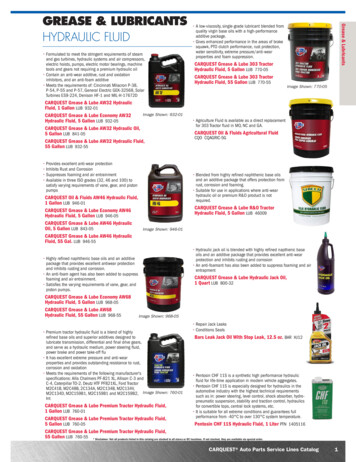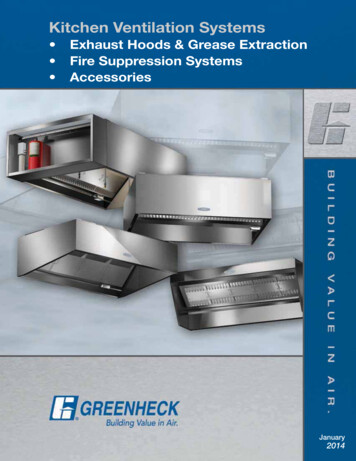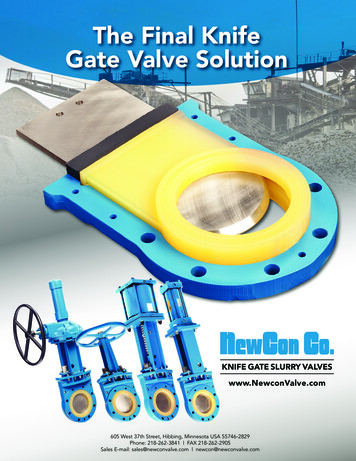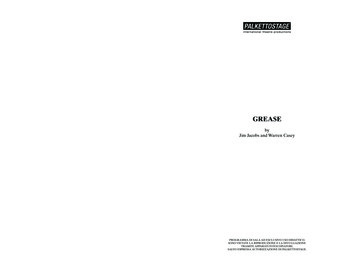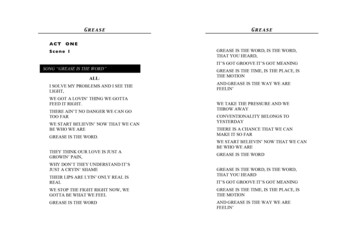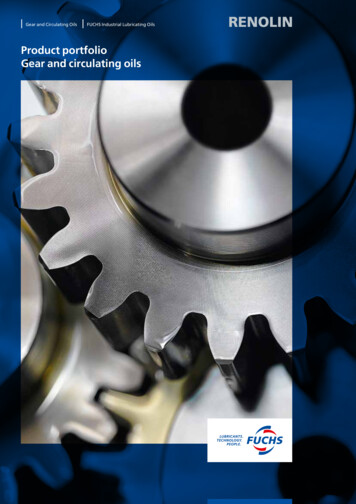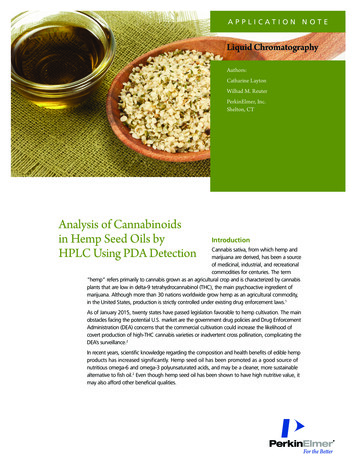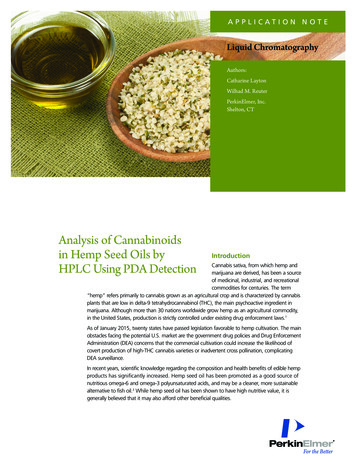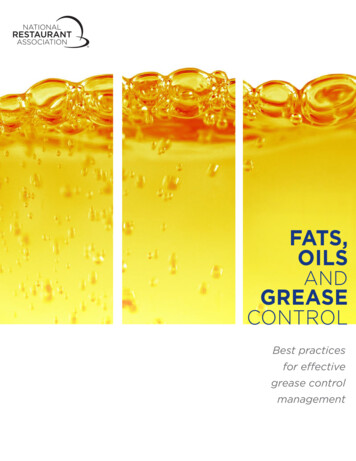
Transcription
FATS,OILSANDGREASECONTROLBest practicesfor effectivegrease controlmanagement
What is FOG?Fats, oils and greases (FOG) are found in mostrestaurants — from cooking oil spilled on thefloor to leftover hollandaise on customers’ plates,and even airborne hamburger grease stuck to yourventilation hood. All this FOG must go somewhereand it usually ends up in your sewer pipes viathe dishwasher, floor drains or the mop sink.Pouring or washing FOG down the drain causes it tosolidify, accumulate and narrow the pipe’s internalopening. Eventually, FOG can completely clog theinside of the pipe, causing sewage to back up into yourbusiness, or onto the streets and into storm drains.These sanitary sewer overflows (SSOs) can:FOG is BATTERSBUTTER/MARGARINECOOKING OILSDAIRY PRODUCTSDRESSINGSFOOD SCRAPSGREASE FROM COOKINGGREASE FROMVENTILATION HOODSGRIDDLE SCRAPINGS Harm our rivers, lakes and streamsICING C ause foul odors for customers andlead to business closuresLARDMEAT FATS R elease bacteria, viruses and other pathogens,spreading disease and endangering public healthSAUCESSSOs are also expensive to clean up. If they occuron private property, the cost is usually borne by theproperty owner. You could also face civic fines andbusiness closures if the SSO is found to be your fault.SHORTENINGFOGNational Restaurant Association Restaurant.org/FOG1
Keeping FOG Out of Your PipesDo This FirstContact your sanitation district(city or county municipality). They will behappy to help you avoid pitfalls and mighteven have free resources (e.g., posters,log books).Steps to TakeThere are three steps you must taketo keep FOG in its proper place:1) ensure you have the correct equipment,2) service that equipment and3) modify employee behavior.FOG Best Management PracticesFollow these practices to ensure you don’t clog up your pipesMUST DODon’t pour excess oil or grease downthe drain. Pouring excess oil or greasedown the drain is a big no-no. You shouldcollect “yellow grease” in special bins forrendering by a third-party contractor.Scrape all extra grease and greasy foodscraps off plates and cookware before usingpre-rinse spray valve and dishwasher. Disposeof excess grease in the trash or recycle it aspart of a food waste recycling program.Install drain screens, particularly in yoursinks, to help prevent much of the grease andfood particles from clogging your pipes.Wipe up grease with a paper or cloth towelbefore using water and soap to clean the floorto minimize grease washing down your drains.Only put non-greasy foods (e.g.,raw vegetables) into your garbagedisposal to minimize the amount ofgrease ending up in your drains.Make sure your employee training materialsinclude these kitchen BMPs, greasecontrol device cleaning and other stepsinto all your employee training materials.SMART PRACTICESKeep these BMPs “top of mind” by requiringrefresher training for your employees.Many sewer agencies require foodservicebusinesses to keep log sheets documentingtheir continued employee training, andmost require annual refresher training.Avoid overflows by inspecting your privatesewer lateral lines periodically using closedcircuit television. Private plumbing contractorstypically perform these inspections, whichcan also identify potential structural issuessuch as cracks, breaks, or root infiltration.Periodically clean your lateral sewer lineto prevent blockages and SSOs. Seweragencies typically don’t clean these pipes,so these lines can accumulate FOG andbecome blocked over time, causing an SSO.Wash out your ventilation hoods regularlyto prevent excessive FOG accumulation.Periodically clean the vents and grease pans onyour roof as well. Make sure you put the leftovercleaning water and FOG in either your greaseinterceptor or via an offsite disposal method.National Restaurant Association Restaurant.org/FOG2
Grease Control Devices (GCDs)What You Need to KnowGCDs can be small or large with associated costs varying widely. Therefore,when you begin budgeting for expanding or opening a new restaurant, makesure you understand your cost liability for GCDs and plan accordingly.GCD Equipment TypesThere are many different equipment options — fromlarge gravity grease interceptors to hydro-mechanicalboxes that fit under the sink. Both the GCDequipment type and size are extremely important tohow well the product functions. Also, the equipmenttype could be regulated in your area so, beforebuying anything, contact your local permittingauthority with jurisdiction over FOG discharge fordetails.Gravity Grease Interceptors (GGIs)COVERSFLOWINLETOUTLETSTATIC WATER LINEGravity Grease Interceptors (GGIs)GGIs incorporate two or more connected compartments, with a minimumvolume of 300 gallons. The GGI’s design leverages its large tank size toslow water entering the device and let gravity (or FOG buoyancy) separatethe FOG from the water (i.e., there are no flow control devices in pipesor baffles in the GGI). Given sufficient space and time, floating greaseand settled solids separate from the kitchen wastewater and accumulatein the interceptor. That’s why GGIs are usually much larger than otherinterceptor designs. If they are too small, the water will speed through thedevice, carrying the FOG with it and will accumulate “down pipe,” causinga backup. The floating grease and settled solids must also be removedbefore they accumulate beyond a certain level to avoid clogging theplumbing or significantly reducing the available space in the interceptor.National Restaurant Association Restaurant.org/FOG3
Hydro-Mechanical Grease Interceptors (HGIs)Removable LidFlow ControlDeviceCleanoutOUTLETINLETAir ReliefFATS, OILSAND GREASESInlet BaffleOutlet BaffleSOLIDSHydromechanical Grease InterceptorIndoor, above ground; 15-60 gallons, 20-50 GPM; 40-100 pounds of FOG storageHGIs (formerly known as grease traps) are made of steel,fiberglass or polyethylene. There are three sub-types: 1) “regular,”which is the basis for the other two designs and that fit underyour three-compartment sink, 2) large HGIs that are a scaled upversion that are typically installed outside the restaurant, and 3)HGIs that include automatic grease removal devices that skim offgrease from the grey water.12“REGULAR” HGISWhile there are many different designs, HGIs typically consist of asingle compartment with baffles/screens to slow down incomingwater/FOG mixture and changing the liquid’s direction. Thisdirection shift forces air into the liquid mixture, allowing FOG torise to the top, solids to sink to the bottom, and water to passthrough the unit. HGIs need flow control devices installed furtherup the pipes to slow water down so the baffles can do their workproperly. This “mechanical separation” allows HGIs to be muchsmaller than GGIs. HGIs are sized based on flow rate and thepounds of FOG they can store.LARGE HGISSome sewer agencies allow larger HGIs that are typically installedoutside either above or below ground, but require less excavationspace due to their smaller footprint. Large HGIs are usually madeof plastic or fiberglass and have internal flow control devices.These devices offer a compromise to a GGI given their largercapacity with lower installation and maintenance costs.Figure placed for scaleNational Restaurant Association Restaurant.org/FOG4
24-hour digital timerRemovable screen basketseparates and contains foodscraps and solidsGrease retention areaINLETOUTLETElectric heatingelementmaintainscontained grease inliquid statefor skimmingDiskimmer removes fats,oil and greaseRecovered grease collectsin disposable containerGREASE REMOVAL DEVICES (AGRDs)3 AUTOMATICAGRDs are a type of HGI that treat kitchen wastewaterfrom food service establishments (FSEs) using gravityseparation aided by vented flow control. They are alsoequipped with automatic grease removal features. Theyare normally installed indoors and connected to one tofour sinks in the kitchen. AGRDs are typically made of steeland are equipped with baffles, screens and external wastecontainers to store FOG waste. Some are equipped withheaters, skimmers, pumps or pressure chambers to assist inthe removal of the FOG.National Restaurant Association Restaurant.org/FOG5
Equipment Types: the Good, the Bad, and the Ugly ( )BenefitsGGICOVERSFLOWINLETOUTLETSTATIC WATER LINEHGIRemovable LidFlow ControlDeviceCleanoutOUTLETINLETAir ReliefFATS, OILSAND GREASESInlet BaffleOutlet BaffleSOLIDSHydromechanical Grease InterceptorIndoor, above ground; 15-60 gallons, 20-50 GPM; 40-100 pounds of FOG storageLarge HGIRemovable LidFlow ControlDeviceCleanoutOUTLETINLETAir ReliefFATS, OILSAND GREASESInlet BaffleOutlet BaffleSOLIDSHydromechanical Grease InterceptorIndoor, above ground; 15-60 gallons, 20-50 GPM; 40-100 pounds of FOG storageJust like “regular”HGI but bigger.AGRD(type of HGI)24-hour digital timerRemovable screen basketseparates and contains foodscraps and solidsGrease retention areaElectric heatingelementmaintainscontained grease inliquid statefor skimmingDiskimmer removes fats,oil and greaseRecovered grease collectsin disposable containerDrawbacksCosts Large FOG storagecapacity Less maintenance Outside installation for easymaintenance and inspectionaccess Maintenance can beperformed during off hours Minimal contact byemployees Requires more space forinstallation Can be source of odors if notmaintained properly More expensive to install H igher maintenance costsper individual pumping events N ew construction restaurants 15,000 - 25,000 Existing restaurant retrofit 25,000 - 75,000 Maintenance 0.20/gallon 0.25/gallon R equires significantly lessspace Less expensive to install Can be made with durablepolyethylene materials L ower maintenance costs perevent Can be maintained by restaurant staff Less FOG storage capacity;more frequent maintenance Requires flow control deviceand additional venting Indoor installation requiresspace for device P otentially indoor odors if lidnot sealed Typically requires healthdepartment approval Inspected or maintained duringbusiness hours A bove ground installation 2,500 - 5,000 New construction, belowground installation 5,000 15,000 Existing restaurant retrofit,below ground installation 10,000 - 25,000 Maintenance Typically abase fee of 100 - 150 perevent Uses less space than a GGI Typically less expensiveinstallation than a GGI Typically made with durablepolyethylene materials L ower maintenance costs perevent than a GGI Larger FOG storage spacethan an HGI Airtight lids prevents odors Less FOG storage capacity thana GGI; more frequentmaintenance Requires flow control deviceand additional venting Indoor installation requiresspace for device Typically requires healthdepartment approval Restaurant staff cannotconduct maintenance N ew construction restaurants 10,000 - 20,000 Existing restaurant retrofit 20,000 - 50,000 Maintenance 0.20/gallon 0.25/gallon D oesn’t require significantspace Lower maintenance costs perevent Self-cleaning resulting in lessfrequent complete pumping Often preferred by seweragencies over regular HGIs Can be maintained by restaurant staff Requires daily, weekly andmonthly maintenance High degree of restaurant stafftraining required No air tight seals; potentialindoor odors M ore expensive than passiveHGI Requires management of recyclable grease container Typically cannot be installedbelow ground Requires flow control deviceand additional venting Typically requires healthdepartment approval A bove ground installation 5,000 - 10,000 Existing restaurant retrofit 10,000 - 15,000 Maintenance Typically abase fee of 100 - 150 pereventNational Restaurant Association Restaurant.org/FOG6
Sizing Your EquipmentCleaning: How Often?Correctly sizing your new GCD (based uponwater flow rate) is incredibly important. Sizingshould always be performed by a professionalplumber and comply within local regulations. Manymanufacturers cite that their products are oftenundersized, installed incorrectly, or both.Cleaning frequency for GCDs depends on severalfactors, including equipment design, restaurantseating capacity, cooking techniques, and localsewer code. Typical cleaning frequency for a properly sized, well-maintained GCD is four times a yearbut could be more often.Your GCD is less effective if it is too small orimproperly installed, so make sure you consider thefollowing before buying a GCD:New Restaurants G et your building permit lined up andapproved. H ire a licensed plumber with ample experienceinstalling grease removal systems. C onsider your future expansion plans and buythe right size GCD (investing a few extra dollarsup front could save you thousands down theroad). I f you sell a lot of fried or greasy foods,you’ll need a bigger GCD. For example, pizzarestaurants produce extra FOG effluent andshould have a larger grease interceptor. I nstall the GCD in an accessible location foreasy access for ease of cleaning. P urchase and install an up-stream screeningdevice to catch food solids before they go intothe GCD.GCDs must be cleaned and maintained regularly tofunction properly. Quarterly cleaning is sufficientfor most conventional GGIs, while weekly cleaningor maintenance is often required for both HGIs andAGRDs, particularly if following effective kitchenmanagement practices.Many sewer agencies have implemented a “25Percent Rule” to assess the maintenance conditionof a GCD. The 25 Percent Rule is the measurementof the floating FOG and settled solids as apercentage of the total hydraulic water depth ofthe GCD. When the thickness of floating FOG andsettled solids layers exceeds 25 percent of theGCD depth, the device needs maintenance. Thisis typically determined by the inspector or foodservice establishment staff using a core samplingtool to measure the contents.Most new restaurants are required to install a GCDto prevent grease from flowing into the sanitarysewer system. This ap
Only put non-greasy foods (e.g., raw vegetables) into your garbage disposal to minimize the amount of grease ending up in your drains. Make sure your employee training materials include these kitchen BMPs, grease control device cleaning and other steps into all your employee training materials. Keep these BMPs “top of mind” by requiring refresher training for your employees. Many sewer .

